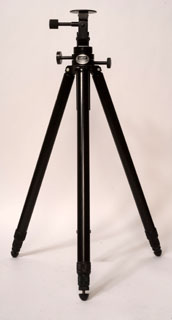

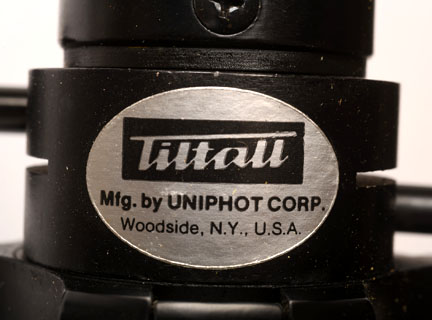
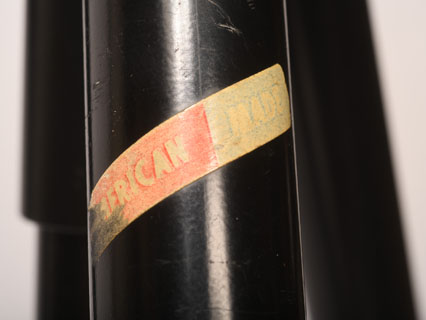

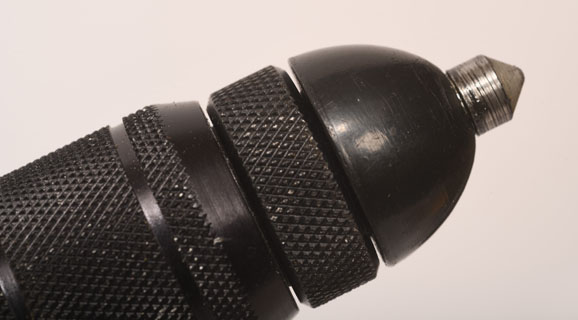
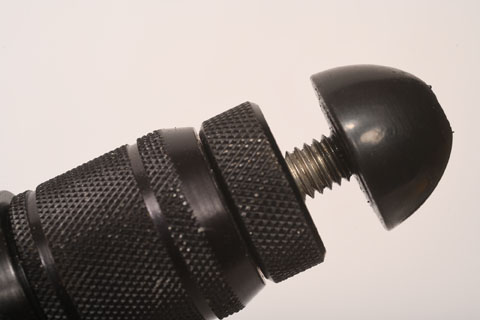
The Tiltall is a classic. 1/4-20TPI tripod screw. Adjustable from 28" high to 74" high. Pan head tilts left/right and forward/backward. Column rises 13". 3 leg sections. Rubber tipped feet convertible to gentle spikes. Tripod is like new + it is newly cleaned, lubed and adjusted. Last I noticed B&H was charging $199.50 + tax for this tripod. Black anodized Aluminum--will not rub off. American made. Light weight. Perfect for most cameras. $125
HOUSTON FEARLESS TRIPOD with RTH HEAD. This is the best designed and best made American tripod......or should I say tetrahedron......a folding tetrahedron at that. Need stability? This is the most stable tripod you will find. Newly cleaned, lubed and adjusted. Newly painted in the original color. The RTH head was designed to accommodate a 200+ pound microwave device. I installed an 8X10" top plate with a 3/8-16TPI camera screw. The camera screw rests below the surface of the tripod top....as it should. I can customize the top plate to work with your camera. Take a look at the Majestic head I customized for use with an 11X14 Deardorff listed on this page; I can do something similar for you and your camera. THIS TRIPOD HAS NO PLAY WHEN LOCKED DOWN. The legs are wide spread......or not. With the legs not so wide spread--as in the 1st photo, the tripod stands 57" tall. With the legs retracted, but wide spread, the tripod is 32" tall. With the legs spread wide and fully extended as in photos #4 and #5, the tripod is 42" high or 49" high with the head--comfortable heights for the astronomer or the photographer. The control arm is a standard pipe; I include 2 pieces of pipe and a 45* coupler. The camera screw I used allows for lots of leverage and ease of use. The feet tilt in 2 directions to accommodate uneven terrain and have a rubber base to protect whatever they rest upon. The feet are reversible to spikes. See the end of this page for much more info about Houston Fearless tripods. The last picture shows the Houston Fearless with a GLENNVIEW 4' long 8X10 camera with a 16" Kodak Portrait lens mounted upon it. This would be a great tripod for an astronomer. Tripod with head weighs 44#. $1500.




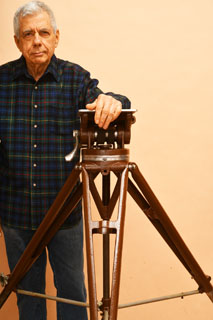


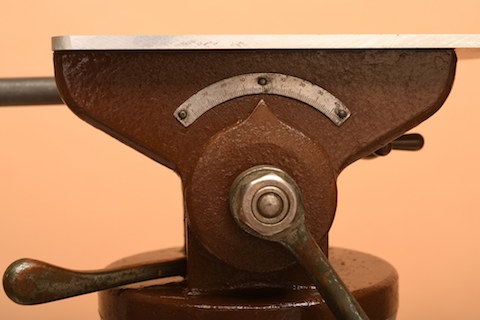
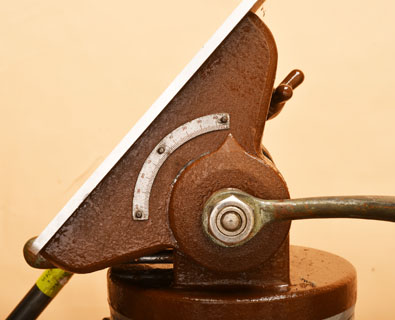
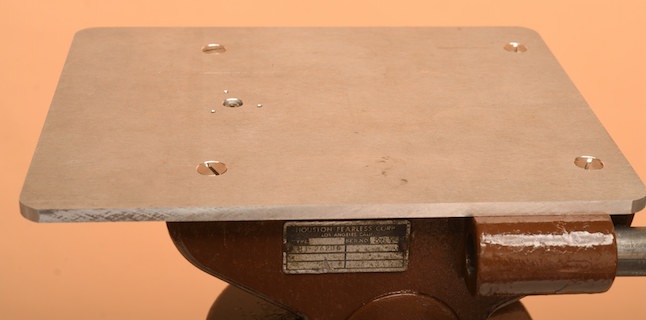
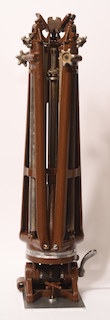
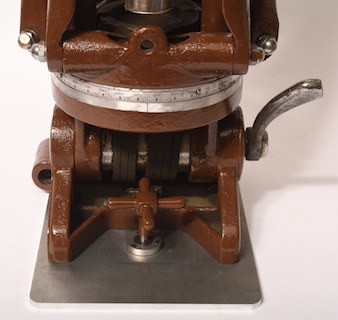
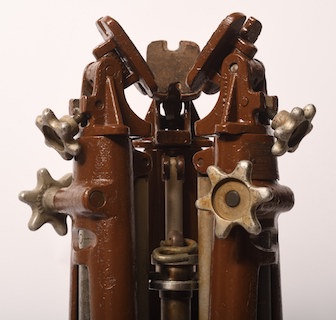

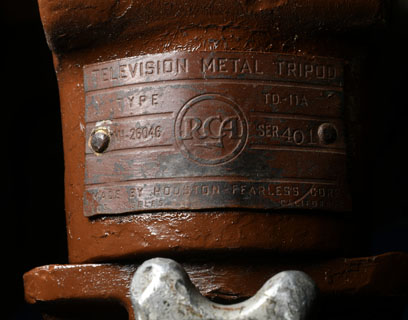


BEARING CIRCLE for HOUSTON FEARLESS TRIPOD without HEAD. This might be useful to an astronomer. 10.25" outside diameter, made of brass. It is sitting on top of the tripod with a piece of scrap metal inbetween. It would be a big job to make an adapter plate to mate with the tripod and the bearing circle, but I can do it, or I will sell you the bearing circle and you can do it. Whoever does it should have the telescope on hand to ensure that the scope can be mounted without interference. The bearing circle is new, government surplus, and is available separately for $150.
I visited the Majestic company here in Chicago in the 1970's. Chicago used to be a manufacturing center. Deardorff Camera was located in Chicago. Burke and James was located in Chicago. Speedotron was located in Chicago. I could hand carry my equipment into these companies when I needed service. I dealt with the heads of these companies. How times have changed!
Majestic head customized, idealized for use with 5X7 or 8X10 Deardorff. The 6X7" platform has 4 screws added to it that keep the Deardorff base plate centered + 2 pieces installed in the camera screw slot that keep the 1/4-20TPI camera screw centered. These alterations make it easy to attach a Deardorff to the head; without looking, place the baseplate onto the head and tighten the camera screw. No more fumbling to center the camera and locating the camera screw into the baseplate! The Majestic head is quite sufficient for the 8X10 Deardorff camera. The crank tilt is good to have for a heavy camera. That 5 7/8" diameter Deardorff base plate is NEW-OLD-STOCK and is listed on my VIEW CAMERAS web page. This head is designed to clamp down upon a 1.5" diameter shaft. I offer a T-adapter that allows you to use the head on virtually any tripod. $OLD. I can custom alter your majestic head for use with a Deardorff for $175.
Camera screws for Majestic heads. 1/4-20TPI was for a very long time the American standard tripod screw, but that changed over time to 3/8-16TPI for large format. Most Majestic heads have 1/4-20TPI camera screws. 3/8-16TPI camera screws were an option, but Majestic parts are no longer available new. I can supply either size camera screw. The 1/4-20 camera screws I have in stock are used original Majestic factory screws. The 3/8-16TPI camera screws I have in stock are a GLENNVIEW product. I am not mass producing these becasue there is no mass market for them. They are laboriously made by hand in my shop and I have to charge enough to cover my expenses. Each comes with instructions and spacer washers in case they are needed. 1/4-20 camera screws are $50. 3/8-16TPI camera screws are $100.
I can make the complete camera screw and knob as well. This camera screw and knob was made for someone who wanted to use 2 railclamps with his monorail camera for greater stability. $200
Platform head for Majestic........or a Majestic to whatever head adapter. 90mm diameter with a Formica covered top plate. 3/8-16TPI camera mounting screw, designed to slip over and clamp down onto a 1.5" column. I can supply one with a 1/4-20TPI camera screw upon request. Excellent base for mounting something other than a Majestic head onto a Majestic tripod. Majestic made something like this, but I did not know that before I manufactured and sold half a dozen of these. So the Majestic version must be rare. Initially, I made one so I could use a Wimberly head on my Majestic tripod. Soon I sold that to someone else who wanted to use another brand head on a Majestic, so I made a run of 3. Those sold out so I made 3 more. Presently I have only one in stock. A GLENNVIEW product. I have also posted an image of Majestic's version, which may be more easily attached and removed and is larger and heavier than my version. Both heads are equally SOLID, but the Majestic version is nearly impossible to find. I have only seen one. A customer I sold one of these to said "Glenn, I received the part today, fits nicely and looks great. Thank you for sending it to me." $150
Custom plug-adapter that goes into the bottom of any Majestic head that is designed to slip over a 1.5" diameter shaft that allows you to mount the head onto any tripod with a 3/8-16TPI head mounting screw (essentially this makes your older head equivalent to a Majestic model 1200 head. $105. Illustrated with the above head. This has been sold, but I can manufacture another one, albeit unanodized, upon demand.

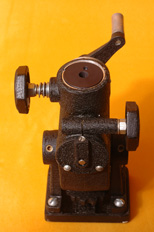
Custom T-adapter to mate with most any tripod. The T-adapter converts a tripod head designed to clamp around a Majestic column to a head that will mount on most any ordinary tripod. A GLENNVIEW product. Specify 1/4-20TPI or 3/8-16TPI threads for the bottom of the T-adapter, $200. This can be custom made for your needs. For instance, the bottom plate could be made custom to fit your tripod directly.


I manufacture custom top plates to fit Majestic heads. The one illustrated is for Sinar cameras, made of black anodized Aluminum, a GLENNVIEW product, Mint-, $150. The 2 silver locating pins locate and align the rail clamp so it is easy to install the rail clamp and the camera is aligned with the geared tilting movement and the rail clamp will not turn on you. I can also manufacture oversize top plates for large flat bed view cameras. Majestic heads are very good large format heads because of their robust construction and the geared tilt. Note: the Sinar top plate has been sold, but I can manufacture more upon demand. And I did just manufacture another Sinar top plate for a Majestic head. I lost my anodizer, so any heads I manufacture in the future will not be anodized. I show several more views of this product for your information. Note that the Sinar head is oriented so that the gear tilts the camera forward /backward, just like the Sinar head does......although the Sinar head is not geared. This is an improvement over the Sinar head. The Sinar head could fall forward or backward when you release the tilt lock. The Sinar camera would be more controllable mounted upon the Majestic head. The configuration of the GLENNVIEW/SINAR for Majestic top plate provides similar conveniece of mounting the Sinar camera. Note that, mounted on the Majestic head, the camera screw rests below the surface of the top plate (just like the Sinar head) when not in use. The person I made this last Sinar top plate for said "Just a note to let you know how much I appreciate your machinist skills. The Sinar top plate works like a charm. Can't believe we've worked without one for so long. Thanks."




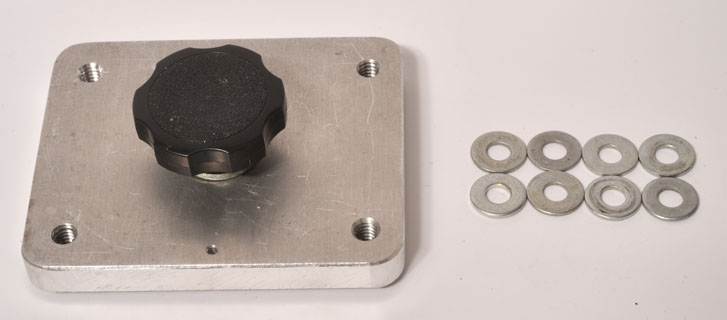
This Majestic head adapted to a custom top plate for a Zone VI tripod was done for a cutomer and is just an example of the custom work I am willing to do for you.

LARGE FORMAT TRIPOD DOLLY. Convenient operation; foot pedal lock and release system. Works with many tripods. Illustrated with a Majestic 4000 tripod. Bogen 3056 Auto Dolly; it goes by another name as well because Bogen changed their product names. NEW-IN-BOX. $125




Quickset was located in a nearby northern suburb of Chicago. Quickset made a range of tripods. Some of their more professional tripods were quite good and innovative in some cases--such as the cam-link heads listed below. Quickset even marketed Houston Fearless tripods rebranded as Quickset. Look at the video of the cam-link head in operation below.
QUICKSET CAM-LINK HEAD OPTIMIZED FOR GITZO, BUT USABLE ON MOST TRIPODS. Originally designed to mount onto Quickset 1.75" diameter column.......and it still will. The base has an 85mm clamp around diameter to mate with large Gitzo tripod tops. It also has a groove around the perimeter to accept the Gitzo safety catch as found on the latest Gitzp tripods. The bottom has a 3/8-16TPI socket to accept most tripod camera screws. Here you see it on a Gitzo 5532s tripod with leveling head. The Cam-Link head has a 1/4-20TPI camera screw on a sliding support that may be turned with the knob for the purpose of screwing it into the camera socket. I made a 3/8-16TPI adapter that screws over the smaller 1/4-20TPI screw. A cam-link head works much like a gimbal head. You may tilt your heavy camera up or down with ease and remove your hand and the camera will stay put. The cam-link head design was patented more than half a century ago primarily for use with heavy TV cameras. Cam-link heads are designed to function with cameras with a specific center-of-gravity height. You will not likely find a cam-link head owner who understands this. I read the patent for the cam-link head and devised a method of testing to determine the center-of-gravity height. Fortunately the head I had purchased had a center-of-gravity height appropriate for my use: I did have to add a short spacer. This head has a locking lever whereas the below head has a knob. It is more stable than gimbal heads, but otherwise functions similarly. Most of the cam-link heads you will find are designed for cameras that no one uses today. This one is great for use with long telephoto lenses like the lens with which it is pictured. This may be the perfect head for Nikon's or Canon's 800mm lenses. This head was disassembled, repaired, cleaned, lubed, adjusted. Accessories were made for use with the head without altering the head. I am using it with an Arca-Swiss compatible clamp, which is included, with a spacer under that. The white Nylon disk unter the clamp centers the clamp in the slot in which it rides. Read the below listing for another such head, watch the video, and note the spare parts available. The Cam-Link head, complete, as illustrated, is $800.






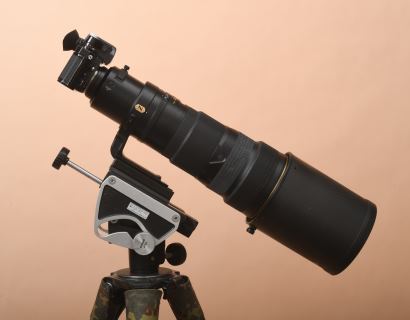


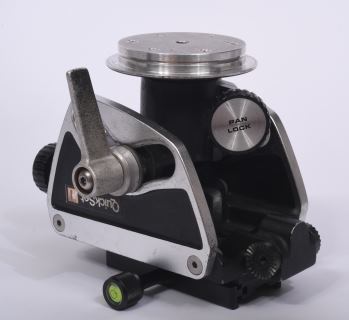
QUICKSET CAM-LINK HEAD. Originally designed to mount onto Quickset 1.75" diameter column.......and it still will. I made a basepost for it with a 3/8-16TPI socket so you may mount it onto most tripods. Here you see it on a Gitzo 5532s tripod with leveling head. That aluminum basepost has 3 set screws that allow you to lock the basepost onto the leveling head. The Cam-Link head has a 1/4-20TPI camera screw on a sliding support that may be turned with the knob for the purpose of screwing it into the camera socket. I made a 3/8-16TPI adapter that screws over the smaller 1/4-20TPI screw. The triple exposure shows the camera screw and the knob that controls it in 3 different positions. A cam-link head works much like a gimbal head. You may tilt your heavy camera up or down with ease and remove your hand and the camera will stay put. The cam-link head design was patented more than half a century ago primarily for use with heavy TV cameras. Cam-link heads are designed to function with cameras with a specific center-of-gravity height. You will not likely find a cam-link head owner who understands this. I read the patent for the cam-link head and devised a method of testing to determine the center-of-gravity height. Fortunately the head I had purchased was just right for my use. I altered it a bit. It now pans and tilts on Teflon bearings. It is more stable than gimbal heads, but otherwise functions similarly. Most of the cam-link heads you will find are designed for cameras that no one uses today. This one is great for use with long telephoto lenses like the lens with which it is pictured. This may be the perfect head for Nikon's or Canon's 800mm lenses. This head was disassembled, repaired, cleaned, lubed, adjusted. Accessories were made for use with the head without altering the head. It is complete with an Arca-Swiss compatible clamp with a spacer under that. $800. An earlier custom basepost is available separately and is listed below. I do not use the handle with the head, but the handle and the T-handle lock screw are included with the head.








QUICKSET SAMSON TRIPOD WITH CAM-LINK HEAD and DOLLY. This is the tripod that Quickset designed the Cam-link head to be used upon. It is not just a tripod, but a tetrahedron. Note that the tripod legs are pinned to the dolly. Combined with the spreader and the dolly, this is a rigid and tight tripod and tetrahedron. Note that the extension legs are not much extended.......there is more height available even without the geared column. The cam-link head is designed to be well balanced with any camera with an about 4.25" center of gravity above the head top plate......such as this Deardorff Triamapro. Note the locking casters. When I was shooting portraits full time I used a dolly similar to this one that I custom modified by epoxying the wheels parallel. This allowed me to roll the camera to and from the subject while staying directly in-line with the subject. If you want that done with this dolly you can do it yourself. As-is, the wheels swivel readily on ball bearings. 1/4-20TPI camera screw. Read more about how the head operates in the above listings. You get all this for the price of one a Glennview custom modified head precisely because no modification was necessary in this case. $800




QUICKSET base post adapter. This will allow you to use Quickset heads on other tripods. In case you are not aware of it, Quickset made some very professional equipment, this cam-link head being a perfect example. I made the base post for my own use, but I can make another, so I offer it for sale. Base post diameter is 1.75", the same as on some Quickset tripod columns, such as the Samson. The post is made of aluminum. An appropriate heat shrink tubing surrounds the post and serves as a bearing between the aluminum post and head. Aluminum should not ride on aluminum! There is a groove near the top of the post to accept the lock screw that keeps the head on the post. Above the post is a slippery UHMW disk that absorbs the friction between the head and the post. The base platform is large in diameter to provide more stability. The camera socket is steel. 3 set screws around the perimeter allow you to lock down the platform to your tripod head. 6 screws attach the base plate to the aluminum base post. You may use the pan brake knob to adjust pan friction or lock down rotation altogether. The cam link head is not included. $200.





QUICKSET handle T-handle lock screw. This was original to the cam-link head seen in the above listing. This is included with the above head, but is also available separately for $25.

SINAR NORMA PAN/TILT HEAD. If you shoot a Sinar, this is the head to have. It was designed specifically for the Norma. 3 of the projections on the top are spring loaded and may be pushed down into the body by a larger than Sinar baseplate. The 4th one is removable. The projections front and rear mate with slots in the bottom of Sinar rail clamps in order to align the rails with the tilt. The head tilts fore and aft; sideways tilt is accomplished by tilting the camera on the rail. The 2 small projections are guides that position the rail clamp so the camera screw is aligned with the rail clamp socket. The camera screw is 3/8-16TPI. There is a secondary tightening screw surrounding the camera screw that makes it easy to solidly tighten down the camera.......something the newer Sinar Pan/Tilt head does not have. The locking lever is adjustable by 60 degree increments. These images are of a head that was sold. I leave them up to show you the Sinar camera to pan/tilt head interface and operation. I now have two SINAR NORMA PAN/TILT heads in stock; see them and other Sinar mounting hardware on my SINAR CAMERAS web page.



You use a tripod for the sake of stability and rigidity. The triangle is the most stable polygon. The tetrahedron is the most stable polyhedron. The tripod set into the ground is essentially a tetrahedron. When you add a column to a tripod, you are adding a good deal of instability. No doubt about it, a column is convenient, but if you can manage to use a tripod without a column, you will have a far more stable setup. Movements and joints all add instability. The more leg extensions you have, the more instability you will have. The more head movements you have, the more instability you will have. Tripod heads are often necessary, but they add instability. The most stable head is a leveling head (not a ball head) built into the top of the tripod. You will find that I have a good selection of tripods without columns and with built-in leveling heads. I have considerable experience photograhing with cameras from small format cameras with extremely long lenses to ultra large format view cameras that require the most stable tripods. Generally speaking, I only deal in those items that I appreciate and would use myself. Tell me what your needs are and I will try to meet them. I will not try to sell you something that will not meet your needs. If I sell you something that does meet your needs, you will more likely be a return customer. My goal, therefore, it to meet your needs, not simply to make a sale. I use or have used many of the the tripods on this list. I have favorites, but I do not attempt to use one tripod for every camera or every situation, and I do not recommend that you do either. The typical photographer requires several tripods for different situations. Tripod weight: A good customer inquired about a tripod for use with his 12X20 F&S. I suggested a Saltzman as the best tripod for the job. He opted for a Gitzo. Subsequently his camera was blown over by a gust of wind in the mountains. Very likely it would not have been blown over had it been mounted on a Saltzman tripod. Even the larger carbon fiber Gitzo is a well built tripod rigid enough to support large format cameras, but your center of gravity will be quite high. Gitzo has a hook on the bottom of some of their center columns for hanging a sandbag or weight from to provide a lower center of gravity and greater stability. A heavy tripod has its advantages.
Tripods for use with very long lenses--such as in nature photography. Tripods can be stable, but lacking in rigidity. A rigid tripod is essential for long lens photography. When your angle of view gets down to a few degrees, you need a rigid tripod. Image stabilization, vibration reduction, or whatever the camera manufacturer calls it helps, but it is not enough with today's high megapixel cameras because they magnify any unsharpness. A sharp lens will only produce sharp images if the support is rigid. You really do need it all working together for you. The best setup is a rigid tripod with a leveling head, the lens mounted on a gimbal head, a center-of-gravity-head or a cam-link head.............and good technique.
Tripods with built-in leveling heads. Cinematographers have long known about the need for stability and rigidity. A normal lens for cinematography is 2 or 3 times the focal length of a normal lens for still photography. Cinematographers oftentimes work with some extremely long lenses. You do not often see pan shots in movies, but you can probably remember a great one or two. Successful pans shots require the best that tripod manufacturers have to offer. That is why cine tripods have no columns. Cine tripods have leveling heads and often one or more spreaders. A spreader converts a tripod into a tetrahedron before you even plant the tripod into the ground. You will find lots of cine tripods with leveling heads and/or spreaders below.
THIS PAGE HAS BEEN REVISED AND REORGANIZED. Saltzman camera stands and tripods are now located near the end of this page. One Houston Fearless tripod is now listed at the top of this page, while information about Houston Fearless tripods is located at the bottom of this page. In keeping with my above mentioned philosophy of what makes tripods perform well, I have repositioned and added to my transit tripod selection.
Tripods for use with transits oftentimes have no leg joints, no columns, etc. Surveyors need to carry with them a long story pole as well, so there is little point in making the tripod collapsable, but more importantly stability is required for holding a heavy brass transit and rigidity is required for viewing through a 24X (or so) telescope. Converted, these make great photographic tripods for field use for nature photography with long and heavy lenses. I can convert these tripods. It is not even necessary to alter these tripods. I make adapters for use with cameras. I also offer Dietzgen top plates that you may alter to accept cameras. If you are a serious nature photographer, seriously consider one of these tripods. I include the GLENNVIEW/GITZO TRIPOD here as well because it has legs with no leg joints. These are relatively heavy tripods. I was working in the forest recently with an 850mm lens on a Gitzo 5532s tripod with a Gitzo leveling head. That is as good a tripod as Gitzo makes. The forest floor was spongy following some rain. Even with the GLENNVIEW spikes on the Gitzo tripod, It was obvious that stability was lacking. Next time I am working in such a situation, I will use one of the below surveyor's tripods.
GLENNVIEW/GITZO TRIPOD. Fixed length Illinois grown hickory legs. Note the 2nd set of spikes on the feet, installed at an angle of 45 degrees for traction when the legs are wide spread. I built this for myself for use in nature photography. In nature photography, you want to be ready to set up asap; you may not have time to extend the legs. No folding legs means fewer moving parts, greater rigidity and lighter weight. Wood is the best material for shock absorption. Most manufacturers stopped using it only because of the cost and difficulty of wood working. The tripod without head weighs 5.25#. The tripod with the gitzo top plate weighs 5.75#. The tripod with the U-head weighs less than 7.5#. The U-head is designed primarily for photographing birds-in-flight; it allows for fluid-like movements without the complexity and weight of a fluid head. The tripod was designed to be fast to set up and function at any height without adjusting the legs. Hickory is a wonderful hardwood often used for ax handles. Each leg is composed of 2 sticks that started out straight. By bending them out at the feet and then back in towards the top, the wood is put under tension. When wood is under tension it becomes extra rigid. The legs and head are glued up using West System epoxy, universally recognized as the best. The Gitzo spider has custom built pan that is as large in diameter as the spider top.....for the sake of stability. My maple U-head has supporting pivot points on either side of the lens.....providing sufficient support without undue stress on a 2# head. Bogen's 3.5# U-head is large and heavy for what support it provides. The Wimberley II head is also 3.5#; it needs to be that heavy due to the extraordinary forces on that single supporting pivot point. My Maple head has adjustable drag, but only one lock......for Arca-Swiss dovetailed feet. 1/2 turn will lock your lens in place. The pan and tilt ride upon needle bearings and Teflon. The pivot points on my head are located at the center of balance of the 500mm Nikkor camera/lens with and without tele-extender and strobe that I use. I keep the movements adjusted so that there is plenty of smooth Teflon style drag. There is no problem overcoming that drag with such a heavy camera/lens. With that drag, just about any large lens that will fit within the 5.125" inside width of the inner U will stay put at any angle you choose. You have more than 45 degrees upward or downward tilt with this head. Note that there is only 1/32" between the inner and outer U. I truly kept the size of this head to a minimun. Hickory and maple are both light colored woods. They are walnut stained to make them fit in with nature. The finish is Polyurethane Spar Varnish with UV protection. The wood used in the legs is 58.25" long. I designed it to be a little longer than usually needed so I can photograph looking up at birds without straining my neck and back. To lower the tripod, I spread the legs farther. I designed and built some stops that will work with the Gitzo spider, but I do not plan on installing them. I wanted to keep all as light and as simple as possible. The 2nd set of spikes will allow you to spread the legs as wide as you like without sacrificing stability or safety. I do not care much for lying on the ground while photographing, but I do like to sit down to photograph. In fact, there is little I like better than sitting beside a marsh or other prime location waiting for my subjects to come to me. My U-head is removable. The Gitzo spider will clamp around any 85mm outside diameter Gitzo head. One photo shows it with an 85mm Gitzo top plate with a custom installed Formica top (available for $75 extra). There is a bubble level on the Gitzo spider and the legs are easy to adjust. A lot of work and design time went into this tripod and head. It is one of a kind. I will not be mass producing them. Buy this one and I will be building another for myself. The image of the wild turkeys is the 1st image I made in the field using this tripod. It is of a group of wild turkeys. The turkeys are in retreat already. They were so far away that I could not tell what I was looking at until I saw them with my binoculars. I do not carry my lens mounted on the tripod. I was not expecting to find wild turkeys or anything else on this mile long hike. I was hauling my equipment in a handcart. I removed the protective cover from the spikes, planted the tripod in the ground, attached the lens and took the picture from a standing position. I aimed at the tallest turkey and the 2 turkey heads just in front of him; the autofocus system focused upon the contrasty outline of the tallest turkey. Truly wild turkeys, as are these, are difficult to get close to, but I was able to get off a shot quickly because it takes very little time to set up this tripod. The photographer I was traveling with did not even attempt to set up knowing that the turkeys would be gone before he could set up. Once I got to the designated location, I set up in a low, seated postion, which is a favorite way to work. The 2nd set of spikes makes it easy to achieve. A naugahyde case (included) protects the tripod. I have now added a readily removable spreader. It utilizes leather hinges. Velcro holds it on the tripod. The spreader adds stability and forces the legs to swing out and retract at an equal rate. I added an accessory tray. The GLENNVIEW head shown on the 2 photos with the spreader is available separately and listed on my 35mm and DIGITAL CAMERA EQUIPMENT web page. $1200







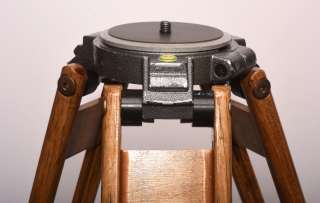


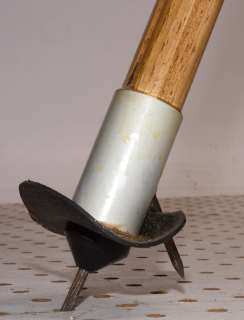



DIETZGEN TRIPOD. I have had many Dietzgen tripods. This is the 1st of the fixed leg style I have ever had. It is a beauty! It is probably at least 70 years old, but looks nearly new. I replaced the leather strap. It has standard 3 1/2" X 8TPI transit threads. Photographic head adapter plates listed below. All the metal parts on the head are brass. The brass parts will not affect a magnetic compass on a transit. The feet are steel. The wood legs are made out of oak; how much sturdier than an oak I-beam can you hope to get! Collapsed, the tripod is ~60" long. Set up for use as seen, it is ~56" high. It weighs 12.25#. It is rigid! $500




DIETZGEN TRIPOD. Similar to the above, but lighter because the top spider is made out of zinc instead of brass and there is a little less wood. It has standard 3 1/2" X 8TPI transit threads. Photographic head adapter plates listed below. The steel feet angle inward. The projections on the feet allow you to push the feet into the ground. Oak legs. Collapsed, the tripod is ~60" long. Set up for use as seen, it is ~55" high. It weighs 11#. It is rigid! $450










Substantial 3 1/2" X 8TPI protective top plate. Flat top and considerable thickness metal make it an ideal candidate for conversion to a photographic adapter. If you convert it you can save some money. Order it asap because I will convert it as soon as I find the time. This is the only one of these that I have. This is priced as it is because of the ease with which it may be converted. $200. If you want me to convert it, the price is $250.


Dietzgen transit base. Solid brass, factory painted with black baked on enamel. 3 1/2" by 8TPI to mount to your tripod. Heavier than and beefier than the protective top plate, which was made out of zinc. Below you will see one of these converted to a camera top plate. There is no easy way to convert a transit tripod to a photographic tripod. This transit base has a flat top and is a better choice than the domed top plate for a photographic converter. Below you will see 2 of these that I have made into photographic converters. This also serves as a protective top plate, cap, thread protector. $50.




Dietzgen transit base converted to camera base. 3 1/2" by 8TPI to mount to your tripod. 3/8-16TPI camera screw. Formica top plate. $200. This is really well made. The Transit base had a large diameter hole in it initially. I threaded that hole and added a threaded plug, which is held in place with West System Epoxy. That was then turned flat, Formica was added to the top and a 3/8-16TPI camera screw added.

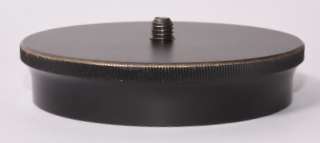

DIETZGEN TRIPOD. Crutch type legs, having a wider base to the triangle add to the stability of this tripod, while reducing the weight. This is the latest model Dietzgen tripod I have. The transit screw is 5/8-11TPI. The wood legs are made out of a fine grained, dense, rigid hardwood. A wrench attched to the tripod fits all lock nuts on the tripod. Collapsed, the tripod is ~63" long. Set up for use as seen, it is ~59" high. It weighs only 11.5#. The protective top plate is removable to make it even lighter. The long metal leg tips will keep the wood legs clean. It is rigid! This may be the sturdiest tripod in my current inventory, $500









BIGFOOT! Another unknown, but GREAT, transit tripod. My guess is that it was made by Dietzgen. This one was obviously made for the military. At 14#, it is quite rigid. Much of the weight is in the large feet; those feet make it especially stable and keep it out of the mud. It obviously has seen little use. There are no moving parts in the legs other than where the legs tilt out from the head and there is virtualy no play in those joints. It has 3.5X8TPI threads to accept some transit. Aluminum and brass parts at top, brass buckle, steel feet. Collapsed, the tripod is 60" long. I am using this for my nature photography because it blends in with the surroundings. $400




Warren Knight tripod. Rigid tripod designed to support a heavy transit. 58 1/2" long. Weighs 8#. 3 1/2 X 8TPI top threads. Oak legs. Brass top. Steel feet. Leg strap needs to be replaced or simply discarded. This tripod would be great for wildlife photography where you need to work fast with a rigid tripod. The wood is solid; No cracks, no splits, no play where it contacts the top or the feet. These are pictures of this tripod before I refinished it.
Warren Knight tripod--refinished while maintaining the original patina. Shorter and lighter than most of the other transit tripods--now permanently converted to a photographic tripod. 58 1/2" long. About 52" high set up as illustrated in 1st photo. Weighs 8#. Oak legs. Brass top spider with aluminum top plate with Formica covering. Steel feet. Nylon leg strap with Velcro closure. The wingnuts allow you to control the friction on the legs which will spread as wide as you choose. Originally a surveyor's tripod designed to support a heavy transit. 3/8-16TPI camera screw. The tripod height was right for use with a particular head, so I put it to use. Finished with Minwax dark red oak stain protected with UV resistant Minwax Helmsman satin Polyurethane. I added some bumpers to the legs so you may close the tripod quietly; I put a single layer of thick electrician's insulated tape around the leg at the junction of the wood leg and the metal feet, then wrapped it with heat shrink tubing. $600
Some transit tripods do have collapsable legs. I list them here to keep all transit tripods in one location and because the 3 1/2 X 8TPI head accessories fit the above and below tripods.
GLENNVIEW Panoramic panhead, for segmented panoramics, has 6 click stops @ 60 degree intervals, 1/4-20 threads top and bottom, Delrin with metal camera stud, suitable for making segmented panoramics with 55mm lenses on 6X7cm, 65mm lenses on 6X9cm, 28mm lenses on 35mm, and other combinations in other formats, 1.2" tall, 2.64" diameter, 4 ounces, Mint, $125 Note: custom panheads also available. Want one with 4, 5, 7, 8, or any other # of click stops, 3/8-16 threads top and/or bottom, larger diameter--no problem. Illustrated is a 5 position panhead on the below listed Dietzgen tripod. So why would you want such an item? Because you can do panoramics with ease and precision. You could do the same thing with a degree marked pan head, but you would have to unlock the pan movment, walk around the tripod, visually set the camera position and relock the pan movement each time. With this panhead, you merely turn the camera to the next click stop and shoot. Foolproof! You can print the images and mount them side-by-side with space in between the images; this method results in no distortion. This method is much like looking out from a gazebo. The alternative is to shoot more images with a lot of overlap and stitch the images together in an image editing program; this result is much like shooting with a swinging lens camera or a rotating camera. You get distortion, but no space between images. Presently I have in stock pan heads with 4, 5, 6, 8, and 10 click stops. Although I could make a pan head with a large number of click stops that would give you several options, I do not recommend it because it would no longer be foolproof. The series of images below were made with a 55mm lens on a 6X7cm camera with a 6 position panhead. You will find a Nikon Panorama-head AP-2 on my 35mm and DIGITAL CAMERA EQUIPMENT web page. $100 for any GLENNVIEW panorama head in stock; $150 for any made to order GLENNVIEW panorama head like the above. I have made and am willing to make other custom panorama heads, similar to the above, but with custom characteristics such as ones with larger bases and double strength click stops for larger and heavier cameras at larger prices.






Dietzgen leveling head tripod with 3/8-16TPI camera screw. With carrying strap and optimized leg spreader chain. Extremely sturdy tripod. I like to push the steel tipped legs into the ground for extra stability. Pushing the legs into the ground makes the tripod one with the earth so that you no longer have a tripod, but a tetrahedron. I have been using it of late with extremely long and heavy lenses and with a Wimberley head. The Wimberley head virtually requires a leveling head tripod. The Dietzgen leveling head is a near perfect size for the Wimberley. I was amazed the 1st time I used it in this manner; I got noticeably sharper images! With an about 15 degree leveling head. With 3/8X16TPI camera stud. Weighs less than 10#. 34-37" collapsed--depending upon how far you push the extension legs into the upper legs. Working height of 52-56" extended. Wimberley head not included. Dietzgen tripods were designed for use with about 30# transits with telephoto lenses, so they are quite sturdy. Additional Dietzgen parts for transits listed on my Optics web page. $450.
C. L Berger & Sons Tripod wood legs. 56" long. 1 1/16" square ash legs with steel feet. Slot at top is 5/16" wide. Designed to accept 5/16" carriage bolts. Weigh 4.5#. Leather strap ties legs together. Ash is what they make baseball bats out of. It is a very stiff wood. There are no tripod legs as stiff and as shock absorbing as a great set of wood legs like these. One of these would make a great monopod. It would be easy to add a tilting top given that slot in the wood with hole. Two legs would make a great bipod; again, that slot with hole would help. I bought them to use in the construction of my own tripod. If you want them, buy them before I get around to using them. $140





Adjustments of the engineer's transit and level by Howard Ives. Dietzgen transit and level exemplified. This came from Dietzgen and is obviously sanctioned by Dietzgen. More Dietzgen literature on my SCIENTIFIC and OPTICAL EQUIPMENT web page. $50


SINAR P CAMERA SCREW, like the one that comes with the P pan/tilt head. 3/8-16TPI and 1/4-20TPI reversible camera screw. May be used on some other tripod heads. New, $25 each.

SINAR and GLENNVIEW 3/8 to 1/4" SOCKET ADAPTORS. Because it screws down from the top of the Sinar rail clamp, the rail clamp is sandwiched between the adaptor and the tripod--providing much greater holding power than the cheap ones that screw in from the bottom. This is the only such socket adapter that I would trust to hold my Sinar. The 1st 3 images show one made by Sinar; I have one available for $30. I manufacture ones that I like better. This GLENNVIEW product utilizes an Allen wrench instead of a screw driver to install it. It is easier to install because it will not fall off of the Allen wrench while you are installing it, made of hardened steel, $30.






GLENNVIEW made 18" mounting plate for use with 2X rail clamps: This mounting plate is optimized for use with Sinar gear. There are slots along the mounting plate that allow you to move your rail clamps between 9 and 12" on center. There are small slots on the bottom side of the mounting plate that engage the Sinar tripod head locating pins--keeping your camera aligned and preventing it from turning on the tripod head. These 2X mounting plates have now been black anodized. The Italian made ergonomic handles are very easy to work with. $275.




Sinar 19.5" long 2X mounting plate for use with 2X rail clamps: Similar to the above. $350


Professional Cine Tripod, 48" closed, 70" fully extended, spike leg tips, extendable crutch like legs, designed for use with a heavy movie camera, 8.25#, Ex+, $OLD w/o head or $OLD with the QuickSet head listed below. The tripod has a Mitchell mount. If you are interested in the tripod by itself and you want to use it with a still camera and/or you want a flat top plate, I have a Mitchell to flat top plate adapter available--listed below.
QuickSet pan/tilt Cine Fluid head, , bubble level, pan, tilt, 1/4-20TPI" spring loaded camera mouting screw with lever lock for easy camera mounting, w/o handle, 2.5X5.25" head top plate, 7.25#, Ex, $OLD or $OLD with the Tripod listed above. This head will fit one of my Oconnor half balls, which has a mitchel mount, therefore it will fit any of my Oconnor tripods. This is a very smooth operating fluid head with a wide useful range of fluid resistance adjustment and with positive locks as well. See images above.
Mitchell to flat top plate adapter. Black anodized aluminum. With tie down and 3/8-16TPI camera screw for use with the above listed tripod. Still available. $150.
ITC-730 mounting adapter. It is in good working condition. It is camera specific. Have the camera it is designed for? It is a bargain. $25.



Fujinon SRD-91 handle. Note that the cord has been cut. It is now just a handle.....designed to be mounted upon shafts of varying sizes. $15.


Fujinon CFH-3 handle. Handle.....designed to be mounted upon shafts of varying sizes. $20.


SCHIANSKY PAN/TILT HEAD. Highest quality design and construction. Schiansky made heads for Linhof and Bolex, etc. Smooth operation. Locks solidly. 1/4-20TPI camera screw. If you need a 3/8-16TPI camera screw, I can make one at a cost of $65. 3/8-16TPI socket in base. Adjustable and removable handle. Most tripods today have 3/8-16TPI camera screws, but some cameras require 1/4-20TPI camera screws. Quality tripod heads with 1/4-20TPI camera screws are uncommon. $275.







Thomas Viscodyne Fluid Pan/tilt head. Separate controls for pan and tilt. Padded top plate 2.5X4.5". 1/4-20TPI camera screw. 3/8-16TPI threaded hole in base with set screw off to the side to lock it down onto your tripod. The base is 3" diameter; you see it sitting on a Manfrotto cine tripod with a 75mm top plate. Very smooth fluid movements suitable for use with video, movie or still camera. Weighs 3# 6 oz. There are 3 threaded holes around the perimeter of the 3" diameter base that would accept legs directly. I use this for a still camera because I like being able to adjust the camera w/o having to unlock something and then relock it--and now digital still cameras have video! Quality fluid heads of a reasonable weight and price are hard to come by. Functions well. $150.
Kodak Friction Pan/tilt head. Separate controls for the pan and tilt. 1.75" diameter top plate with knurled perimeter on the face of the top plate. 1/4-20TPI camera screw. 1/4-20TPI threaded hole in base with knurled perimeter on the face of the bottom plate lock it down onto your tripod. Smooth friction controlled movements suitable for use with medium weight movie or still camera. Weighs 10 oz. 2.75" high, by 1.875 by 3". There is a 1/4-20TPI threaded hole for a handle about 5-5.5" in diameter. Ex+, $50. Tested: will support a 6# camera.
These photos show the bottom of an 8X20" GLENNVIEW camera. The squirrelly lines around the tripod socket are from my fishing for the socket while trying to mount the camera--before I added the head guide ring shown. You can get tired of that with a heavy large format camera. So I added the head guide ring that is designed to make it easy to mount the camera on a tripod. The inside of the ring is slightly larger than the diameter of the tripod head and has a slight taper. Now, w/o looking it is easy to mount the camera on the tripod. The head slips right into the ring and is automatically centered; you may then tighten the camera down on the head with relative ease. I got this idea from using the Dietzgen tripod listed below. The large 3.5" diameter screw threads on the Dietzgen make it easy to mount the camera, but not as easy as this design that I came up with. I use a Bolex tripod with the 8X20" GLENNVIEW. This head guide ring would work even better with the Berlebach tripod and because the Berlebach tripod is definitely designed for large format, I highly recommend that you puchase a complementary ring with screws to mount to the bottom of your camera. I can supply either wood screws or machine screws. The head guide ring with screws is $125. I can supply a head guide ring for a Bolex tripod, a Berlebach tripod, a Gitzo tripod, virtually any tripod with a round head, and even for tripods with other than round heads. Cost will vary.
The differences between the latest Gitzo tripods and previous generations of Gitzo tripods: The "G-lock legs" of the latest tripods are the most notable difference. The G-lock legs are a great improvement. Now, a quick twist of the leg rubbers locks/unlocks the leg at that joint only. The latest tripods have a higher load capacity rating even though the legs may be the same as on the immediately previous generation. The "spider" now has a secondary safety lock. The secondary leg lock is located on the inside ring between the primary clamp around lock and the bubble level in the 1st image. By pressing the button underneath the safety lock, you may unlock it as I am doing in the 2nd image. I do not believe the new spider is stronger than the older spider. I think the increased weight capacity "rating" is due mostly to the secondary lock. I never had a head come out of the older spider unexpectedly. Initially, I began using the newer tripod with the several older heads that I had. Twice I had the heads come out of the spider unexpectedly. It was then that I machined my older heads to make them compatible with the secondary safety lock. I recommend that you do not use the newer tripods with heads that are not compatible with the secondary lock. It is not necessary to machine a groove all the way around the clamp around diameter as Gitzo has done. It is only necessary to machine an about 1/2" long groove of the appropriate width and depth at the approptiate location to accomodate the secondary lock. As you can see in photos of older heads below that I have machined, I can do that very neatly and professionally. The charge for that is $50. There will be a cost savings if you have me machine multiple heads at the same time. I can also add a set screw to older Gitzo tripods that will engage the groove in newer heads at a cost of $50



GITZO/GLENNVIEW PLANTABLE MONOPOD. I combined a leg from a large aluminum Gitzo tripod with a ski pole and a stilt foot rest and an Arca-Swiss compatible clamp with a simple tilting support. Push the ski pole into the ground, and you have a free standing monopod. I built this for myself. I like to do nature photography, which sometimes involves following action across a wide field. I found that tripod legs can get in the way. Not so with a plantable monopod. The ski pole in the ground provides your pan movement. It is easy to turn and follow action while swiveling around a planted monopod. It is also more stable than an unplanted monopod.......plus it frees up your hands. If you prefer to use a different head, remove the top section of the Gitzo leg, which reveals a 3/8-16TPI camera screw at the top of the next section of leg. Although not as stable as a tripod, most of the time you will be using a high enough shutter speed to stop the action anyway. The image of the Sandhill crane was shot from this planted monopod @ 1/4000 second with a late afternoon northern Illinois November sun. These Sandhill cranes were put up by a Coyote, but they really did not want to spend the night elsewhere, so they flew around until they found a safer place nearby to settle down. I was able to follow them with ease.....working from the planted monopod. This was just the 1st of dozens of images......all equally sharp. $400




TELE STUDEX G505 COMPACT PERFORMANCE TRIPOD with top plate. Various columns and heads available below. In its day, this was Gitzo's top of the line tripod. It is notable for its compact folded length and its full extension height and its low height with the legs fully spread. This tripod functions like new. The legs move in and out smoothly. Leg locks work well. Bubble level is in good condition. The leg diameter was the largest that Gitzo offered. The weight crrying capacity was as high as it got. 85mm clamp around diameter; accepts new and old series 5 heads and columns. It does not have the secondary head locking system of the newest tripods, but I can add a set screw (at a cost of $50) that will engage the newest heads with a secondary lock that will offer greater weight capacity and security from the head coming loose. 3/8-16TPI threads. The leg tips on this model are not interchangeable. Weighs about 9#. $400










EXTENSION LEGS AND SPIKED FEET. 3/8-16TPI threads. 1" diameter by 2" long Delrin body. Hardened steel spikes extend out 1.2". I use these on a Gitzo 5532s tripod, which is slightly short for my needs, but now the height is just right and I only have to extend 2 leg sections. I use similar leg tips on my custom altered Bolex field tripod listed below on this page and found that they work extremely well in the field. Combined with the tapered extension leg, they provide as firm a footing as possible in the spongy ground along river bottoms. They are easily pushed into gravel paths found in forest preserves--essentially forming a super sturdy tetrahedron shooting platform. They even work well on rock and cement. They are dangerous, so I use a cover cap on the folded legs; on the other hand, they make for good self defence if needed (Remember the film Blowup about a photographer who defended himself with his Marchioni Tiltall?). The spikes are firmly seated in an undersized hole + they butt up against the set screw. Rubber washers keep water and mud off the legs and out of the threads. The washers are shown after having been in the mud along a lake for half a day. All components, the design and construction are made in the USA. This GLENNVIEW product is available nowhere else. The cover cap is available for $60 extra, which includes an interior medium density foam block that provides protection from the spikes. The last picture shows a Glennview spike alongside a Gitzo aluminum spike. These spiked feet have been in use for a year or 2 and they have not been bent nor have they been dulled. Masonry spikes are very hard and tough. I checked my lower leg bushings recently and found that they did not even need cleaning. Those rubber disks keep the leg bushings clean. $120







Gitzo leveling base or head for series 3/4/5. 85mm clamp around diameter--for large Gitzo tripods. 70mm clamp around diameter below that for smaller Gitzo tripods. The lever attached to the 3/8-16TPI camera screw allows you to gently screw the camera down onto the base, then lock it down as much as necessary with the lever. I replaced the cork top with Formica because it is more durable and is more solid. This was especially machined to work with the new tripods with the secondary safety lock as seen in the last picture. $190



Gitzo clamp, 85mm inside diameter. This is required, in addition to a top plate, to use your Gitzo 400 or 500 series column as a side arm. Remove the column from the tripod, install the top plate onto the top of the tripod, mount this clamp onto the top plate, insert your column into the clamp. 3/8-16TPI threaded hole in base. You can also mount this on a tripod and mount the below plate in this clamp--providing you with a solidly mounted top plate in the vertical plane. $80.

This Gitzo top plate is for larger Gitzo tripods. The short cylindrical collar just beneath the top of this plate is 85mm in diameter; this is what your tripod clamps onto. The Gitzo top plate is the lightest weight, most stable and most compact head available for your Gitzo. I have 2 available. Note the slight differences. Your choice. $60 each.




This Gitzo top plate is for smaller Gitzo tripods. The short cylindrical collar just beneath the top of this plate is 70mm in diameter; this is what your tripod clamps onto. The Gitzo top plate is the lightest weight, most stable and most compact head available for your Gitzo. Gitzo product #GI349. $50.

Gitzo dual top plate. Useful for when you want to video alongside your still camera, do stereo photography.....or whatever. Useful for when you want to isolate your microphone from your noisy camera. Useful for dual camera stereo images. Its usefulness is only limited by the photographer's imagination. The tripod socket is 3/8-16TPI. The camera screws are 1/4-20TPI. $50.


Gitzo 4" half ball. 3/8-16TPI camera screw. 3 screws in the top plate allow you to lock down your tripod head. $100 by itself or $80 with a tripod. This will fit either of the Peter Lisand tripods listed below. It will fit a Miller tripod that will also accept the 100mm half ball listed below. It fit a Vinten tripod with a 100mm bowl which I sold.

Gitzo accessory disk with level. Center hole has 3/8-16TPI threads. Designed to screw down onto the camera screw of column tops 87mm or smaller in diameter. Aluminum with cork top to protect your camera gear. Illustrated on the below listed Gitzo G1525 column. New condition. $60.



Gitzo G1525 17" black column with removable hook. 85mm clamp around diameter for larger Gitzo tripods. This was especially machined to work with the new tripods with the secondary safety lock as seen in the last picture. $190.


Gitzo short column and/or sleeve. 5" column and phenolic sleeve. 1 3/8" diameter column. 1 1/2" diameter phenolic sleeve. These came from the part you see in the 1st image. I used the collar in adapting a Saltzman head to a Gitzo tripod. You may see the collar in use on the Saltzman head near the top of this page with the Saltzman equipment. That leaves the short column and the phenolic sleeve each of which is available for $60, or both for $100.


Gitzo wing nut locking collar for Gitzo's largest diameter leg. For a #5 series Gitzo tripod. Also serves as a center column locking collar for a #4 or #5 series Gitzo tripod. NEW, $25. I also have 4 used ones available @ $10 each.


Phenolic bushing for Gitzo's largest diameter leg. For a #5 series Gitzo tripod. NEW, $25.
Gitzo largest leg dent remover. For a #5 series Gitzo tripod upper leg with the wingnut lock. Run this steel plug through the leg to push the dent out. If the dent is too bad, you will have to first drill a hole in the dent. $75

Gitzo plug feet. For many of Gitzo' lower legs. About 25mm diameter. They are meant to be tight fitting so they do not work their way out. NEW, $5 each or 3 for $10 or 12 for $24. They have mold release talcum powder on them; I wiped it off of one.

Gitzo plug feet. About 29mm diameter. NEW, $5 each or 3 for $10.

Gitzo spiked feet. Screw threads are 8mm or 3/8" diameter. Only one spike, NEW, $8. The rubber feet fit over the spike, NEW, $5 each or 7 for $30.

Gitzo halfball parts. Aluminum halfball and handle. Brass screw. Top plate mounting screws. $25

Gitzo G1548 replacement leg lock bushings, full set, 18 pieces total. I do not know if these are still available. I tried to search for them at gitzo.com with no luck. You know how manufacturers are today. They do not want to support older products. They want to sell you a new tripod. Gitzo changed hands recently. When I tried searching for similar spare parts from Gitzo they told me that predated their acquisition of Gitzo and the parts were no longer available. If you own a Gitzo 1548 tripod, I suggest you buy these parts because they will be the 1st thing to need replacement from ordinary wear. $90.


Gitzo G1548 replacement leg lock bushings. Partial set. Used. Still serviceable. Someone replaced all the leg lock bushings. Each leg lock requires 2 bushings. One smallest leg lock went bad. All leg lock bushings were replaced. 2 small bushings were no good and discarded. $40.

Gitzo replacement leg lock bushings for older metal tripods. Partial set. Used. Still serviceable. Phenolic. The larger ones are for legs with an OD of about 1.5". The medium size are for legs with an OD of about 1.25". The smaller ones are for legs with an OD of about 1.125". I think these are for the 3 top leg sections of a #5 Gitzo metal tripod. It looks like one of each size may be new, and one of each size used. $80.

Bolex tripods are a favorite of mine. Made in Switzerland decades ago, they are very high quality. They have not been made for a long time, so it is important that you find a Bolex in good condition.
Bolex tripod with adjustable height center column, leveling head, stop blocks and live rubber feet. Reversible 1/4-20TPI and 3/8-16TPI camera screws. Quick action lever lock leg clamps. 33" collapsed, 67" maximum height, weighs 8# 10 oz.--and worth every ounce. Fully functional. D-ring added to one leg for a carrying strap. $350.
Bolex tripod with adjustable height center column, leveling head, stop blocks and live rubber feet. Reversible 1/4-20TPI and 3/8-16TPI camera screws. Quick action lever lock leg clamps. 33" collapsed, 67" maximum height, weighs 8# 10 oz.--and worth every ounce. Fully functional. Like the above, but with the addition of a carrying strap and Velcro leg wrap. Metal parts extremely clean, but the rubber feet, although still live, are cracked. $400.
Bolex tripod, with leveling head, convertible spiked and rubber tipped feet, removable stop blocks and live rubber feet. Reversible 1/4-20TPI and 3/8-16TPI camera screws. Quick action lever lock leg clamps. 33" collapsed, 55" maximum height, weighs 7#. Remove the stop blocks to spread the legs wide. Live rubber feet with still sharp spikes indicate that this tripod was little used. There are some cracks in the rubber feet. The lack of a center column provides you with more stability and less weight. The eyelets at the middle of the legs may be used with a chain to keep the legs from spreading too far when the leg stops are removed. RARE in this very clean condition. $400.
Bolex field tripod optimized for use with a Wimberley II head. Leveling head. Reversible 1/4-20TPI and 3/8-16TPI camera screws. Fixed length legs. About 54" working height, 59" collapsed. You do not have time when photographing fauna to set up a folded tripod. You need to be ready to shoot ASAP. Fixed length legs are sturdier than legs with joints. The parachute cord allows variable leg spread and therefore variable height. I have shot with this tripod on steep slopes, while still maintaining level. The hardened masonry nails in the leg ends are long to get through the leaf litter, etc. Those spikes are securely set into both the legs and the black anodized aluminum leg ends, which are epoxied onto the hardwood legs. Those spikes will provide serious protection if needed. Camoflage tape is wrapped around the leg ends to keep them quiet and in place when collapsed. A Velcro leg wrap may be used on the leg ends or the leg middle. I prefer the Velcro at the leg middle because I can reach it easier. The next to the last image shows the components of the leg ends before being anodized and installed. The last image shows the lengths that I go to to do the job right; I am neatly and accurately drilling holes in the tripod leg ends to receive the masonry spikes set into epoxy. Weighs 7#. This is a very sturdy Bolex. It hangs level for carrying with a Wimberley II head. A lot of effort went into the conversion. Camoflage painted. The handle has now been black anodized. $600.
Bolex tripod lower legs. The top caps get replaced after the legs are installed. The rubber tips were removed to reveal longer spikes for field use. $80.
Bolex leveling head, about 15 degree tilt in any direction, handle extends below tripod, handle locks tilt, reversible 1/4-20TPI or 3/8-16 TPI camera screw, $150. Designed to work with some Bolex tripods, may also work with Shianski tripods as Shianski made these particular Bolex tripods. Above see photos of tripod that shows how this head is attached and functions. Diameter of head base that slips down into tripod top casting is 50mm
Bolex pan/tilt head. Adjustable position hollow handle accepts cable release through it, quick release built-in with Q-R camera plate with 3/8-16TPI camera screw, 3/8-16 TPI socket in base to mate with tripod, pan base marked in 15 degree increments, base 90mm diameter, built-in bubble level, 4.5" tall, weighs less than 2.5#. Top plate is 2.25X3.25" in size. Illustrated on a Bolex tripod with column and leveling head, which are not included. This is the cleanest Bolex pan/tilt head I have and the cleanest I have ever seen. You probably will not be able to find a Bolex head as clean as this one. $175.
Bolex pan/tilt head. Identical features to the above head and almost as clean as the above head, with the most notable exception being the paint chip on the front that is clearly visible in the photo. $150.
Bolex pan/tilt head. Identical features to the above heads, but without the handle. Not as clean as the above heads, notably the missing paint on the front face and on the tilt scale. $110.
Bolex camera mounting plates and screws. I have 3 different 3/8-16TPI camera screws and plates available. See photo for differences. You may have your choice with the above heads. If you need a mounting plate with a 1/4-20TPI camera screw, you may find one on the used market elsewhere or I can make one for you if necessary. A customer needed one with the camera screw offset 3/16". That one is seen in the 2nd photo on a different configuration Bolex head that has been sold; it is made out of hardened steel with a separate screw. The screw is over long in this view. Before I cut it to length I asked the customer the ideal length for his needs. I understand the needs of the photographer and I aim to please. I can make custom phtotographic equipment for you; of course, you may expect to pay a custom price. The B&W photos show that custom mounting plate in use on my customer's beautiful Kodak Cine Special II camera. The offset camera screw allowed the camera to be mounted onto the Bolex head such that the camera controls and the magazine could be operated as intended without conflict with the tripod head. Purchased separately from the tripod head, these Bolex camera mounting plates and screws are $75 each, your choice.
The OCONNOR STORY: An engineer and amateur photographer was photographing with his self-built tripod. Walt Disney saw him and ask him to build tripods for him. Now that is a recommendation!
OCONNOR METAL TRIPOD with SPREADER and LEVELING HEAD. 3/4-16TPI stud on head will accept virtually any head you wish to put on it, although you may not need another head with the built-in leveling head. Maximum 56.5" working height. Minimum 26.5" working height. 37" folded length. Weighs 14# 6 ounces. Look at the cross section of the leg. Built to be as light as possible and still hold a heavy camera. Newly cleaned, lubed and adjusted. This has been my personal "really long lens" tripod for some years. This model Oconnor is more solid than any commercially made tripod I have worked with, but I wanted to raise the performance level to the ultimate, so I added some extras to it because absolute stability is required to obtain the best results with really long lenses. The center wood triangle creates a "tensegrity" structure. Tensegrity is one of many words created by Buckminster Fuller and refers to the integrity of structures in balanced synergy between tension and compression. The wood triangle pushes out slightly on the tetrahedron formed by the tripod and lower spreader, creating the tensegrity to make the whole RIGID. The triangular support under the camera eliminates virtually all flexure found in any long lens mounted only at one point + it takes up what play there is in the camera and lens joint + it takes up the play that may exist in whatever other head you are using on top of the leveling head + it eliminates movement of the camera due to mirror slap. Virtually all such Oconnor tripods were sold for professional use and are almost always very well used. This Oconnor was not much used, and has been rebuilt by me for my own use. All 6 spikes present. Leg ends all metal. Tripod SOLD. The triangular wood tensegrity accessories are available separately for $200. The lens and the gimbal head are not included, but both are available separately. The gimbal head will be listed when I find the time. The 500mm F4 Nikkor G VR lens is listed on my 35mm and Digital Camera equipment web page.
TENSEGRITY ACCESSORIES for OCONNOR TRIPOD. The triangular wood tensegrity accessories illustrated with the above metal Oconnor tripod will also work with wood Oconnor tripods. $200
OCONNOR WOOD TRIPOD. Similar to the metal tripod illustrated above. Oconnor C-440-0 top casting with about a 4.5" bowl. 60.5" working height. Collapsed length, 40". Weighs less than 9#. Only one spike in each leg end. All 3 plastic leg ends have been altered and and will not hold a 2nd spike. This tripod utilzes the same size halfball and tie down (117mm diameter top plate) as the above tripod. I added a cord spreader to ensure that the legs will not slide out from under your expensive camera. $225 as illustrated or $400 with the below listed top plate and tie down.
TOP PLATE AND TIE DOWN for OCONNOR C-440-0 top casting with about a 4.5" bowl. Because I got tired of waiting for an Oconnor half ball and tie down to show up, I made my own top plate and tie down. It is not a leveling head, but it is solid and functions well. Unlike your typical Oconnor camera screw, this one stays put as illustrated, yet it turns as necessary to lock down your tripod head. It is a black Formica covered Aluminum top plate. $125.
OCONNOR HALF BOWL with MILLER LEGS TRIPOD. Oconnor C-440-0 top casting with about a 4.5" bowl. About 58" working height. Collapsed length, 40". Weighs 9# 10 oz. Two original spikes in each leg end. All metal hardware. The cast metal leg ends are labeled "made in Australia" as are Miller tripods. I have seen other Oconnor tripods with Miller legs; maybe Miller made legs for Oconnor. Miller legs are good! Oconnor half bowls and tie downs, etc. are available with tripod. The double spikes on the legs are quite useful. I was working from within a blind on a windy Winter day that threatened to blow the blind away. I could not use the blind tent pegs because the ground was frozen. I was able to spread the legs wide in order to hold down the 2 front corners of the 5X5' blind using the double set of tripod spikes to engage both the ground and the blind tent peg loops. The rear of the blind was held down by the tongue of my equipment bugger through the bottom of the blind entrance hole. See my 35mm and DIGITAL CAMERA EQUIPMENT web page to see an equipment bugger. This tripod utilzes the same size halfball and tie down (117mm diameter top plate) as the above tripods. $500.
OCONNOR SPIDER. Oconnor C-440-0 top casting with about a 4.5" bowl. This spider is the same size as found on the above 3 tripods. $100.
OCONNOR HALF BALL WITH TIE DOWN. Fits Oconnor C-440-0 top casting with about a 4.5" bowl. This half ball fits the above 3 tripods. Half balls are rarely available separately. For MItchell heads; if you want to use another head, I have adapters available.......see below. $300.
OCONNOR MITCHEL MOUNT BASE. Mates perfectly with the 4.5" Oconnor half ball and the 4" Mitchell tripod top. For most other heads you are better off with the below adapter plate because the screw housing you see protruding above the top of the plate is 5/8-11TPI, not the standard 3/8-11TPI. The protruding part of that screw housing may be machined off, allowing the 3/8-16TPI screw underneath to be exposed, but the length of the protruding 3/8 screw will be a bit short. $150.
Adapter to convert Mitchell top plate on Oconnor leveling head for use with still cameras. The metal Oconnor listed above came with a leveling head for use with Mitchell heads. I needed a flat top plate with a 3/8-16TPI camera screw. I replaced the original camera screw and added a black anodized Aluminum top plate. I have since sold the tripod with the original setup, so the adapter parts are available. What you get is seen in the last image--the custom camera screw, the top plate and a threaded retaining washer. The custom camera screw replaces the original camera screw that came with your Oconnor Mitchell head. This flat top plate will fit other Mitchell heads such as the one listed above with the Miller Professional Cine Tripod. A GLENNVIEW product available nowhere else. Note that the top plate is captured by the threaded washer, yet the screw will still turn. $175.
OCONNOR SUPER CLAWBALL tripod. With an Oconnor hard plastic case (the best case in the business). All 6 spikes present. Leg ends all metal. Oconnor tripods are some of the sturdiest and best engineered tripods in the business. This one is especially sturdy because it is short and stout like a bulldog. Consider this tripod for any purpose where you need super stability at a short height. Consider it for your astronomical telescope. Working height range about 2 to 3 feet. Tripod weighs 13#. Weight with case is 24#. $300.
5/16-18TPI SPIKES to fit most Oconnor tripods. Set of 3. $75
Oconnor leg guides to fit some Oconnor metal tripods. Set of 3. $20 each or 3 for $45
KNOBS FOR OCONNOR 30 HEAD. Your choice for $20. All 4 for $30.
Miller Tripod with 100mm bowl, half ball and tie down. Leveling head with 3/8-16TPI camera screw. The little post on the top of the half ball is for use with some Miller heads; it is removable. Nylon cord spreader. Feet with 2 spikes each. A fine tripod. A "classic." $500
Miller 100mm half ball and tie down. Both 1/4-20TPI and 3/8-16TPI camera screws included. Illustrated on the tripod it came in on; tripod not included. $150 for the one with 2 camera screws. $135 for the other one, which did not come in on this tripod.
Miller Spider with100mm bowl, 100mm half ball and tie down. The paint was stripped off and the Miller nameplate was removed; it is all ready for painting or anodizing. $300
Miller 100mm "spider" . Both are fully functional. Your choice, $150. When I built my own tripod, I chose to use a commercially manufactured spider rather than make my own. I used a Gitzo because that is what was available to me at that time. I would have been just as happy with a Miller spider. See the tripod I built with Gitzo equipment listed above. The paint was stripped off and the Miller nameplate was removed from the shiny one, which is all ready for painting or anodizing.
Miller 100mm "spider" homemade by someone else into a highhat. $125 or $100 for the spider without the extra parts.
Miller 150mm "spider," halfball, tie down, handle, 3/8-16TPI camera screw and pan/tilt FLUID head (all but the legs). All works as it should. $450
Another highly respected tripod manufacturer. Well designed, sturdy tripods with leveling heads.
Peter Lisand JR-A-74 tripod. 4" bowl mount. Mid-level spreader. Spike tipped legs. Case. This is an extraordinarily sturdy tripod. 41" collapsed. Minimum height, 33". Maximum height, 58". Weighs 12#. $400.
Peter Lisand Ultra T tripod. 4" bowl mount with leveling half ball and tie down. Adjustable mid-level spreader. Spike tipped legs. 38" collapsed. Minimum height, 31". Maximum height, 56". Weighs #. This tripod shows considerable use, but it is fullly functional. Tripod with spreader and leveling head, $250.
Peter Lisand Ultra T series #113-B fluid head. The head tilt works well. The head pan does not work. Buy this for parts only. $25.
Sliding quick release with 3 camera plates. Came in with the above Peter Lisand Ultra T series #113-B fluid head. I have separated it from the head because the head is being sold for parts only. I made the 3 camera plates (1 of Aluminum, 2 of maple) to mate with the sliding quick release. I left them blank so they can be custom fit to your equipment. I will be glad to custom fit the top plates to your equipment for a fee. Illustrated with the above head, which is not included, but available and priced separately above. $125.
Bogen Carbon One 3443 carbon fiber tripod. Center column may be removed and installed horizontally. Rubber tipped leg ends. 3/8-16TPI camera screw. Wide spread legs. 3 set screws come up through the top plate to engage and lock down the head if you choose. Bubble level. Wrist strap. Tripod weighs 3.5#. Tripod is 24.5" collapsed, 50.5" at full height, 66" with column extended. Lever locking legs are fast operating and are one of the best features of the tripod. Because this is so light weight, yet sturdy, and fast operating it is a pleasure to use. $250.




Bogen Carbon One 442 carbon fiber tripod. The lever locks make setting up the tripod easy. The leveling head is an integral part of the tripod which keeps the weight down and the stability up. No column means greater stability. The tripod has wide spread legs with 2 fixed angles. The maximum working height of the tripod is 51" or 57" with the GLENNVIEW gimbal head. This CARBON FIBER tripod weighs 4 3/4#. The tripod is 25" collapsed. I added the Bogen reversible spike tip and screw out rubber tipped feet. The tripod is available by itself for $325. I used this tripod with other components in my lightweight WILDLIFE PHOTO OUTFIT. The lens has been sold. The gimbal head is listed just below. A leveling head works especially well with a gimbal head. Set up the tripod, level the head and you may pan and tilt all you want using the gimbal head and remain level. The Kirk collar and foot is listed separately on my 35mm and Digital Camera equipment web page, where you will find more photos. All 3 three items are available as a package for $800. Prefer a different tripod? I am amenable to that. The image of the green heron was made with this outfit.



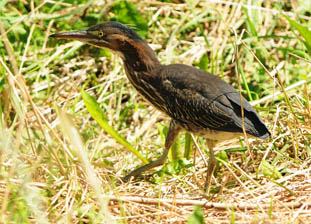

LARGE KIRK BALLHEAD with ARCA-SWISS COMPATIBLE CLAMP. 3/8-16TPI socket on base. One image tells the story. Large locking knob with smaller tension adjustment knob on the opposite side. Pan lock knob near base with 15 degree panoramic angle window visible just above base. Looks and functions like new. For all formats to 8X10. Good for 35mm and digital cameras with long lenses. $300
AUTOMATIC DRIVE! DESIGNED FOR ASTRAL PHOTOGRAPHY. MAY BE USED FOR ORDINARY PHOTOGRAPHY. I have used it with my Nikon D850 for shorter videos by setting the camera for time lapse photogaphy. It does come with a cellphone or smaller camera mount. Long-lived rechargable batteries built-in. USB socket used to charge it. Case included. 1/4-20 TPI socket and camera screw. There are lots of tricks you could do with this head. $125.


MANFROTTO RUBBER NECK HEAD. 1/4-20TPI stud at one end. 1/4-20TPI steel threaded socket in the other end. Weighs 3 ounces. About 2" long X 1.5" diameter. Illustrated with a Nikon F2 with 300mm F4 Nikkor PF lens. Smaller than a D cell. You may tilt your camera 90 degrees. Of course you will want to hold your camera still for most shots. You will be hard pressed to find a smaller or lighter head. $25
UNIVERSAL ADAPTER DISK. This 1/2" Formica covered (on both sides) aluminum disk has 3/8-16TPI threads throughout with a removable 3/8-16TPI to 1/4-20TPI threaded adapter in one end. It comes with 3/8-16TPI stud and 1/4-20TPI stud. There are many possibilities. Formica is hard and resists abrasion and gouging when backed up by the Aluminum disk.....yet it does not mar your camera. 2.35" diameter. $125
Angeles tripod head, 3.625" diameter top and bottom plates, 2.25" high, one way tilt only, 1/4-20TPI camera screw and hole in base of head, suitable for 4X5 and smaller, Ex, $40, or $75 with ratcheting type lever handle (in stock) instead of the wingnut.
When it comes to long lens nature photography, MOST HEADS ARE TOO COMPLEX, TOO LARGE AND TOO HEAVY. These heavy duty heads do have their place for use with large and heavy lenses, but I advocate for small and lighter lenses as well. I tried the Wimberly and many others, but I was dissatisfied with all of them. What is needed is the simplest of heads, preferably with no locks other than friction locks. You have to gently trip the shutter no matter what head you use, so a friction lock is sufficient. And you have to be able to follow the action quickly. If you have to unlock controls before attempting to follow action, you are unlikely to be able to keep up with the bird. I am constantly on the lookout for better designed tripod heads, but I find nothing acceptable, so I build my own heads. You will find some of my heads listed below.
GLENNVIEW pan/tilt head with a single locking lever for both morements. ~3" long Arca-Swiss clamp.. I designed it for use with a Nikkor 500mm F5.6 PF lens. I use this lens primarily for photographing birds and wildlife. I may use it not tightened down or I may tighten it down with the single lever. That lever is adjustable. You may position it at any angle by pushing a button in the center of the lever and repositioning the lever. In use, it takes only about a quarter turn to lock the lever. Weighs only 8 ounces. $300




Small and lightweight GLENNVIEW controlled friction gimbal head. I designed it for use with a Nikkor 300mm F4 AFS lens. It will work with any lens similar in size and weight. I am now using it with the 500mm F5.6E PF VR lens. I love it. I suspect that it is only the 1st in a series of gimbal heads I will design and build. Its simplicity is what makes it work so well and weigh so little. The design is based upon the particular qualities of friction from the very slick UHMW, a plastic designed as a bearing material and the strength and rigidity of the black anodized aluminum. All major parts are bearings. It works very smoothly with adjustable friction settings on pan and tilt. It may be balanced with a teleconverter on the lens as well. 3/8-16 TPI threaded hole in steel insert in base, Arca-Swiss style quick release clamp. Bubble level in the center of the base. The head weighs 1# 1 ounce. Less is more! $400. This head is available in a discounted package; see above Bogen tripod listing for details.


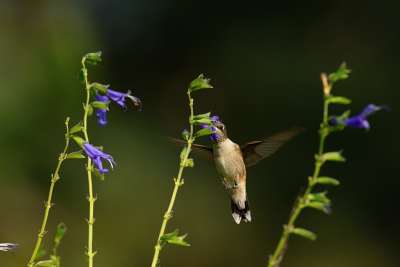





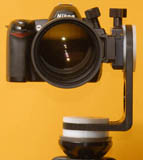
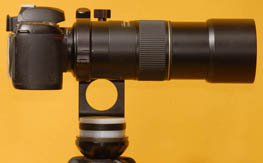
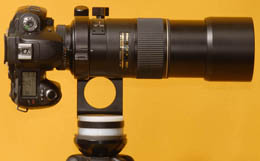

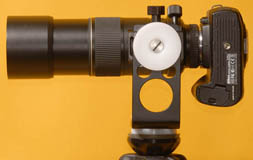
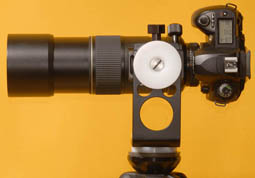
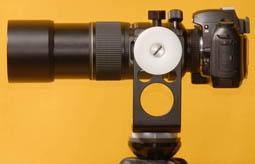


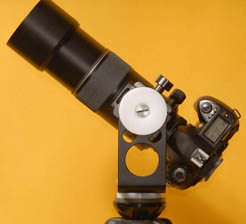
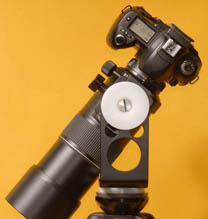
GLENNVIEW MONOPOD HEAD. 3/8-16TPI socket on L-aluminum base with factory made Arca-Swiss compatible clamp with swiveling base. No locks. There is a smooth gentle friction to the tilt movement. To pan, turn the monopod. The L-aluminum is about 2" wide and optimized for use with Manfrotto monopods, but it also works with larger diameter top plates. See it illustrated on a 4" top plate on a large Gitzo tripod to show that there is plenty of offset to clear and also to show that I use it with a 500mm F5.6 Nikkor Phased Fresnel lens. I get far more good images with this lens than I did with 500mm F4 and 600mm F4 lenses because this small and light weight lens allows me to work faster. $100



MANFROTTO 3245 SEMI-AUTOMATIC MONOPOD. This tripod has both 1/4-20TPI and 3/8-16TPI camera screws, with the larger thread spring-loaded around the smaller; no parts to get lost! The upper part extends out with the help of gravity when you press the hand lever. It retracts as you push down with the lever pressed. The lower part is hand adjustable; follow instructions as indicated on monopod. 26.5" collapsed. 62.5" extended. One of the best monopods available. $75






Feisol Carbon Fiber Ballhead CB-50. With camera mounting plate. Accepts Arca Swiss size dovetail mounting plates too. A near perfect match for the Bogen Carbon fiber tripod listed above. I use the Bogen with this head with a Nikon D200 with a 300mm F4 lens with 1.4X tele-extender; it is plenty sufficient for that and makes for a very light weight and portable outfit. The manufacturer claims it will hold something like 15 kilograms. I like the safety catch. You may release the lock, but you must also release the spring-loaded safety catch to remove the camera plate. The camera plate has a textured rubber surface that grips the camera gently but securely. $175. Note that the Feisol camera plate is not illustrated in these photos because the lens has a built-in Arca Swiss compatible mounting plate.



Toledo Cine Engineering tripod head or lab jack, very high quality, smooth operation, has simple geared rise, self braking, no locking mechanism necessary, Ex+, $80. This would work well for correcting parallax.
Saltzman studio camera stands $OLD. I have only this one adapter to fit Saltzman studio camera stands. Be Careful! Do not buy any Saltzman head thinking it will fit your camera stand or tripod. The mounting shafts on the 2 are different diameters. The head for the tripod will not fit the camera stand and vice versa. The camera stand accepts a 1.5" diameter shaft. The tripod accepts a 1 9/16" diameter shaft.
Saltzman adapter to fit Saltzman studio camera stands. 100mm long. Allows you to adapt any head that accepts a 3/8-16TPI camera screw to the Saltzman camera stand. Also with 3/8-16TPI socket on bottom. 1.5" diameter shaft. Screw this into your camera and put into Saltzman stand, then clamp this part and the Saltzman stand itself provides support for your camera. $100.


NOTE: Saltzman tripod heads are the absolute best for ultra large format flat bed view cameras. Custom mounting plates can be made that fit your camera perfectly; I'll do it for about $100 to $200. Especially reccommended for all 11X14 or larger cameras.



Saltzman revolving handle for tilt crank, with screw. The crank handle is rare. A part for the crank handle, available separately, is next to impossible to find. You may see this part on the crank in the above images and by itself below. $50.

Saltzman was a great engineer. He really understood metals. Saltzman field tripods, although heavy relative to most other tripods, were made as light weight as possible without compromising strength. Saltzman field tripods are made of Magnesium, Aluminum, brass and steel as necessary. You will find no plastics or rubbers on Saltzman gear. That is why Saltzman equipment is so durable. Anything that old made of plastics or rubbers would have long ago deteriorated.
Saltzman head. There is no head equal to the Saltzman head. The Saltzman head is the best head designed for use with large flat bed view cameras. This Saltzman head has been sold. I adapted it for use on a Gitzo tripod. I machined a Gitzo part to accept the Saltzman shaft, making for a very neat looking and well functioning and less expensive adaptation. Then I adapted it to make mounting of an 11X14 Deardorff easy. I added 4 screws to the top plate that contain and center the 11X14 Deardorff logo baseplate over the camera screw. I made a new camera screw and associated hardware that resides below the surface of the top plate....and is screwed into the camera after the camera is sitting on the baseplate. The customer I made this for said "Saltzman Head arrived yesterday WOW!!! I am impressed. Works like a charm and indeed is the best arrangement for such a big camera. I can think of no other set-up by any other manufacturer that would serve my needs better than this one that you have put together for me." If you ever tried to mount an 11X14 Deardorff onto a tripod without such a positioning system you would understand why this customer is so satisfied. Without such a positioning system, it can be extremely difficult and risky to hold the camera while visually trying to position (center) the baseplate over the camera screw and trying to screw the camera screw into the baseplate. The photo of the 11X14 Deardorff was provided by the customer. I do not have any Saltzman heads in stock, but I am willing to adapt your Saltzman head for you.







GLENNVIEW/SALTZMAN tilt crank handle with revolving handle for Saltzman head. The revolving handle is by SALTZMAN. The rest is by GLENNVIEW. The original Saltzman tilt crank handles get lost because they are removable. $150

Saltzman camera screw retaining plate. This mounts underneath the top plate and accepts the slotted camera screw (see photo of camera screw above). The little projetion into the hole at the end of the slot is oftentimes missing, which can result in your losing your camera screw. $OLD, but you may buy a top plate to get one or i can remove one from a top plate and sell it to you for $50

Saltzman top plates. The one on the left is an unaltered original 9X9.5" Saltzman top plate. The one on the right is an altered Saltzman top plate, 5.5X7.5" in size. Both have the steel guide retainer for the original Saltzman camera screw on the bottom side. $100 for the 9X9.5" Saltzman top plate. The smaller altered top plate has been sold.

Custom Saltzman top plates made to fit your camera, about $100 to $300. Typically these will be for dual rail flat bed view cameras. The top plate will replace the original and will be the width of the rail and long enough to fully support the main rail section and the joint between the main rail section and front and rear extension rails and partially support any extension rails. See photo below of custom top plate for another tripod.
Saltzman studio camera stands (2 were available; both now sold) For your information I have put this information back up. Perhaps the strongest studio stand ever built. You could hang yourself from it suspended 4' from the column. The 4" (3" on smaller stand) square chrome plated center column is triangularly braced to each of the three legs with poles running from top to leg ends. The camera support arm rides the column on 8 bearings and is connected to a counterbalanced weight inside the column via chains that run up to the column top and over sprocketed wheels. The stand has large casters and a hand crank at one leg that turns three feet simultaneously to lift the casters and the whole stand up off the ground to stabilize the stand. The camera mount is triangularly braced to the center column, and is adjustable; you can even swing the camera up and shoot over the top of the Saltzman camera stand. The camera can be positioned anywhere from near floor level to 12' (11' on the smaller stand) high. Need a huge copy stand?--use the floor as your copy board and mount your camera on a Saltzman camera stand. One stand is 10' 6" high, the other is 9' 4.5" high. Your choice, $OLD. Available heads on shafts ready to use on the Saltzman stand are a Saltzman ($OLD) or a universal top plate on shaft that is part of the Sinar head adaptation illustrated--but will work with virtually any head @ $OLD (with stand). The Sinar pan/tilt head has been sold. I also have available a custom clamp to hold a bicycle; the stand serves beautifully as a bicycle repair stand. The 1st image is from a Saltzman catalog. Clicking on the image will give you a different larger image with info from the manufacturer. Were I to photograph the camera stand as a whole in my studio there would be too much clutter in the background. So I will provide some images of parts of the stand. Camera stand with Saltzman head supporting a 50# plant. Sinar head on adapter and the adapter by itself. 11X14" camera on stand. 14X17" camera on stand. Camera stand being used as a bicycle repair stand. Think outside the box. These camera stands have many possible uses. I sold one camera stand to a manufacturer who was planing to use one to hold a mirror.







Custom tripod for 7X17, 11X14 or 12X20 F&S or any other similar folding rail wood cameras. The holes for the camera screw are optimized for the F&S cameras; holes may be added for other cameras. Surveyor's tripod Aluminum legs. 12X13X.25" Aluminum top plate supports the whole width of most flat bed view cameras and the joints between rail sections to provide superior support. 3/8-16TPI camera screw with large easy to handle wingnut for locking down the camera solidly. Removable canvas and Nylon shelf doubles as leg spreader. No tilts. Variable leg extension levels the camera. Rubber tipped feet screw in to reveal spikes. Mounting the legs at the edges of the tripod top provides far superior stability. Illustrated with a 12X20 F&S camera with 44" extension that I built and sold. About 14#. $400.
TABLETOP TRIPOD. I like this Minolta tripod for several reasons. The rubber feet will not harm your tabletop. The design (modeled after the Leitz) is stable and compact. The ballhead is sufficient, but not overly large. 1/4-20TPI camera screw. It comes with a case. $75


SPOTTING SCOPE TRIPOD or TABLETOP TRIPOD, cast Aluminum, super sturdy, legs fold, nylon case. The reversible center column has 3/8-16TPI threads at one end and 1/4-20TPI threads at the other. A set screw keeps the center column in perfect position--wherever you need it. I left the 3/8" screw long because I thought I might want to add a larger diameter top plate to the center column for use with the Feisol head listed above which is often what I use with the tripod, but I found that the 30mm diameter tripod center provides plenty of support for the 69mm diameter Feisol baseplate. So, when I mounted the Leitz ballhead upon the tripod, I readjusted the center shaft and reset the set screw. The case will accomodate the tripod and either head with room to spare. That Leitz ballhead is my favorite because it gives you your choice of 3/8-16TPI threads or 1/4-20TPI threads at each end. $125 for the tripod without head. $300 for the tripod with either head.



CUSTOM EXTRA LONG LEITZ TRIPOD HEAD SCREW. It will only fit this model Leitz head. This is the head with 1/4-20 and 3/8-16 threads at top and bottom. It will only work with the 1/4-20 threads on the top because that threaded screw is too long to reverse. It could serve as a replacement for the original if the too long threads are shortened. Photographed beside the original Leitz double ended screw for comparison. $50


UNIVERSAL CLAMP UNIT. This is a Sinar clamp unit that I have converted. It is designed to be clamped onto flat or round surfaces up to 73mm or 2 7/8" thick. There are "V-grooves" in the clamp and the clamp screw that grasp flat or round objects particularly well. The screw foot tilts and swivels so that it will also clamp onto odd shapes. With this you can mount your camera in places where your tripod will not fit. You get the clamp unit with a 92mm diameter Formica covered aluminum mounting plate that will fit on the clamp unit in either of 2 positions. A 3/8-16TPI camera screw is also included. The Gitzo round clamp is also slightly altered to fit the clamp unit in either of 2 positions. A Gitzo leveling head is mounted in the round clamp. The Gitzo parts are priced separately and listed elsewhere on this page. A Gitzo side arm or a Gitzo 85mm diameter flat plate may be used in the round clamp. $OLD, but I can make another or you can make your own. The main part is available as part of a set on my SINAR CAMERAS web page.






TRIPOD HEAD MOUNT FOR 7/8" DIAMETER BAR. You see it mounted on the handlebars of the above Worksman PAV-3. It is 2" in diameter. It has a 3/8-16TPI stud. There is a formica top to protect your camera and this mount. Most bicycles have 7/8" diameter handlebars. A GLENNVIEW product....available nowhere else. $200. Add another $200 if you want the Manfrotto head, which I have adapted to accept Arca-Swiss compatible dovetail camera and lens plates. There have been nature photography excursions where I have done all of my photography from my trike.




Magnetic camera plate, chrome plated steel with a strong magnet underneath, 3/8-16TPI threaded camera screw. Of course, you could also add a ballhead or some other head to it. Illustrated attached to the side of a computer minitower with a Hasselblad SWC attached. When I was removing the magnetic plate with camera from the computer, I almost pulled the computer over--strong magnet! $70
Ballhead, made in Germany, ~2" tall, 1" diameter body, 1.25" diameter metal top plate with 1/4-20TPI camera stud, 3/8-16TPI tripod socket, Ex, $10 each, 2 available
Ballhead, made in Germany, ~2" tall, 1" diameter body, 1.25" diameter top plate with 3/8-16TPI camera stud, 1/4-20TPI tripod socket, Ex, $10
Kalimar light duty tripod head with suction cup for use on smooth surface, with ball head controlled by long handle (1st I've seen), Mint, $10
QuickSet Samson camera wall mount. Flat plate mounts to wall with 4 screws. There are holes for mounting to the wall and for mounting your tripod head or camera to this, but no screws included. Can be used for still camera, security camera, light head. $50

Riflestock. For use with cameras with 1/4-20TPI threaded sockets. In addition to the camera screw it also comes with a set screw with a dog point for insertion into the video camera smooth socket just to the left side of the tripod socket. Not all cameras have this video camera socket. The dog point set screw in the video camera socket will keep your camera from turning at the threaded socket. Illustrated with a Nikon D850 with a 500mm F5.6 PF lens. Made of aluminum; it is very strong and very light weight. $125.




Riflestock. Same as the above, configured differently. A Wimberley Arca-Swiss mount has been added. A grip post has been added. Your lens will have to have an Arca-Swiss dovetail foot in order to use this setup. The advantages are obvious; you have a hand grip for your left hand and you may move your camera/lens to and fro to ideally position it. Illustrated with a Nikon D850 with a 500mm F5.6 PF lens. This is my preferred setup for wildlife photography. You will also receive the camera screw/knob and the set screw with dog point shown in the above listing--and if you prefer that configuration you may return the Wimberley clamp and the grip post for a $150 refund. $250.


Wimberley C-10 Arca-Swiss clamp. Wimberley makes such fine equipment! They use a harder than usual aluminum and then hard anodize it--after it is very finely machined and finished so smoooooth! The C-10 is no longer made, so it is only available on the used market. Here are 2 of them that someone put together for a special project. I was so glad to find them because I had used the only C-10 I had in the construction of a Leitz Valoy II copy stand for a customer. These 2 are available together for $250, or separately for $125 each. The 2 screws and the Allen wrench go with the one that was altered. What I like about them other than their super high quality is the locking set screw off the the side of the main mounting hole. I also like the flat bottom with simple screw holes. The replacement for the C-10, the A-12, has a 4-leaf clover pattern surrounding the main mounting hole and no set screw off to the side.




Novoflex shoulder support. There is a lot to like here. This is highly adjustable. It has 2-3 inches of length adjustment. It can be adjusted for left or right shoulder use. The camera mount (the block with the Novoflex name on it) may be turned to any of several distinct angles in either direction. The camera mount has a video camera post (rare) in addition to a 1/4-20 camera screw so that your camera will not turn once mounted. The camera mount may be removed and used independently. There are fittings for a strap on the front side of the shoulder mount, and the original strap is included, although not shown. Overall length is about 10-14". I like using this with my D850 Nikon with short and/or light telephoto lenses such as the 300mm F4 Nikkor PF lens or the 500mm F5.6 Nikkor PF lens. $200

Doormount for 1980's Toyota minivans. The top hangs from the top of the door (with the inside ruibber strip removed) just inside the window on either the drivers side or the passengers side. The bottom slips into the armrest. The ballhead has about 15 degrees tilt. Use your van as a blind for photographing wildlife. $200.




Chestpod, sits on chest, adjustable straps around neck and around chest, wood camera post with 1/4-20TPI brass camera stud, weighs 13 oz., Ex+, $10
REVOLVING SHOOTING PLATFORM AND BLIND. Designed for my own use in following birds in flight. I sometimes sit for hours in a blind. Following birds in flight can be challenging from a fixed seat positioned behind a camera mounted on a fixed tripod shooting through a fixed window opening. I have literally fallen off my seat while trying to follow a bird in flight. I wanted to improve my performance capability along with my comfort. This is the solution I came up with. It will allow you to follow your prey 360 degrees. the seat and even the blind window all move together. It would work just as well for hunters as photographers. The 3/8-16TPI screw on the front post mount will accept a photographer's gimbal head or a rifleman's V-support. The backrest is adjustable in height. The 4 legs are independently adjustable in height. There is a bubble level on the seat X support. Level the shooting platform and your horizon will always be level in your viewfinder. A 12" diameter ball bearing turntable provides stability along with smooth rotation. Redwood was used to keep the weight down. The redwood was soaked in a specially thin epoxy, then joined with West System epoxy before being being coated with UV proof outdoor polyurethane. A well padded seat provides the comfort you will need for sitting hours on end. A lightweight umbrella blind mounted in the backrest post, combined with lightweight camoflage netting forms the blind. Everything weighs only 16.5#. Upon my 1st use of this revolving shooting seat and blind, a Great Egret flew in before I was completely settled inside the blind. Deer were unaware of my presense. A Great Blue Heron and other waterfowl, including skittish Mallards that are used to being shot at, flew in. I was able to get dozens of images of the Northern Harrier as it flew around the lake looking for prey. The Harrier got pretty close, was curious, but showed now fear. Not only did the revolving seat and blind provide comfort, but I was much better able to follow the prey. When you are trying to follow a subject with your camera and lens mounted on a tripod, the tripod legs get in the way and if seated, you may be unable to follow the subject without falling off your seat. In the last photograph, which was recently added, notice 2 changes. Seaky leaves were added to the netting and the camera support post is now black. Recently I found it difficult to install the netting on a windy day. The covering would have blown around in the wind, which would have made the blind ineffective, so I just used the revolving shooting platform. Now that was pleasant! My vision was unrestricted! Being situated low to the ground within taller foliage, it was more of a natural blind. When you are situated low and are relaxed, you are less of a threat to wildlife. I enjoyed the day much more and I was successful. The next time I needed a blind on a cold and windy day I used the revolving shooting platform inside of a commercial blind--which was far more successful than using a tripod and a separate seat. So realize that you are buying primarily the revolving shooting platform. The blind is included, but it can be frustrating to use. $500
SMALL QUICK RELEASE SYSTEM. Made of a solid block of black anodized Aluminum. The quick release plate is about 1.25X1.75" and about 1/8" thick. The ballhead is not included. 1/4-20TPI socket in base and 1/4-20TPI camera screw. $40.
Tripod shoulder bag, weighs 1#, 33" long 5.625" ID round opening, hard bottom, works great for Bolex, Tiltall and other similar sized tripods, shown with Bolex tripod inside, small side pouch, also with short handle under shoulder strap, designed as a golf bag, $25
Tripod case. An Oconnor case and a Peter Lisand case are listed above with the tripods. Although included with the tripods, the cases are available separately. The Oconnor hard plastic case is $175. The Peter Lisand hard fiber case is $100. See the tripod listings for size and other details.
3/8-16TPI to 1/4-20TPI thread adapters. All, various configurations. $50

Vinten foot. $20


Linhof ballhead top plate. ~50mm or ~2" diameter. 1/4-20TPI camera screw on one side, 3/8-16TPI camera screw on the other side. $20


Craig Thallhammer Model B tripod legs. Hardwood. Reversible extension legs with rubber tips on one end and spikes on the other end. One wingnut has broken ears, but still works. Legs extend to at least 54". $40

Craig Thallhammer tripod top plate. The diameter of the section below the top plate is 1.5". $25

Other tripod parts listed above with the brand tripod. This space is for orphan tripod parts.
2 Crown #4 tripod legs. Note that the top ends of the leg in the foreground are damaged; this leg may be repaired. The other leg is fully functional. $50 for the one good leg. $60 for both legs. I have a full set of #4 Crown legs and a rarely found spreader packaged with a circuit camera on my PANORAMIC CAMERAS web page.

HOUSTON FEARLESS TRIPOD. I have had a lot of tripods over the years......Saltzman, Gibralter, Hercules, Oconnor, Dietzgen, Foba, Gitzo, Arriflex, Vinten, etc., but none was as substantial and as supportive as this Houston Fearless. This tripod was designed to support well over 200#. Superbly designed and made! With all the triangulation in this tripod it is far and away the best heavy duty tripod I have had. It was designed for professional use with large and heavy 1950s TV production cameras and 35mm and 70mm movie cameras. The rubber bottomed feet tilt in 2 directions......or you may lock the feet into the spiked position. The legs may be extended equally using the numbers on the legs. Each foot may be bolted to whatever for semi-permanent mounting. There is an eye under the bottom of the center column for attaching a weight. Heads are interchangable. The cradle type head listed below fits this tripod. When you fold up the tripod, the legs are captured by a spring loaded ring on the center column.....so the legs stay in place until you release them; you must release the ring to open up the legs. The tripod stands about 48" high when legs are fully extended. Tripod stands 32" high when folded. When someone needs the sturdiest tripod avaiilable, this is the tripod of choice. $OLD.






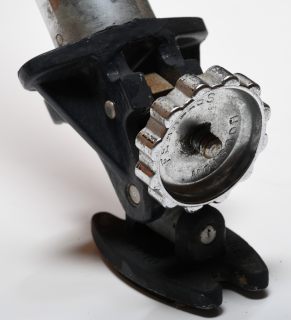

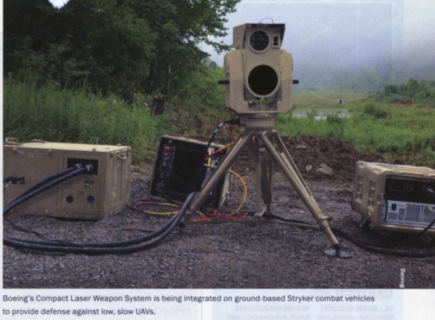
HOUSTON FEARLESS CRADLE TYPE HEAD. Designed for use with extremely large and heavy 1950s TV production cameras and 35mm and 70mm movie cameras. By centering the weight of the camera over the cradling pan and tilt head, a heavy camera may be maneuvered with ease. It has a spring-loaded 3/8-20TPI camera screw that is turned with a T-wrench. That T-wrench also moves the camera platform back and forth to properly locate the center of gravity of your particular camera and lens. That T-wrench is stored under the head platform. The essential T-wrench is often missing from these heads. 20" long, 9" wide. 7X8" camera mounting platform. It weighs ~23#. Houston Fearless was a company owned by Howard Hughes. This head would be useful today for the person working with a Nikon or Canon 800mm lens, anyone working with ULTRA LARGE FORMAT, or for the astronomer. Houston Fearless cradle heads are quite rare as only well funded production campanies could afford them. That is a GLENNVIEW 16X20 camera sitting on the head. $OLD





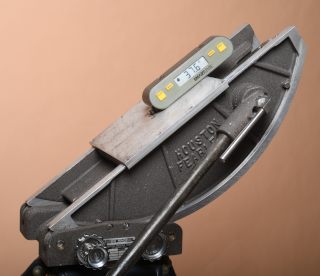
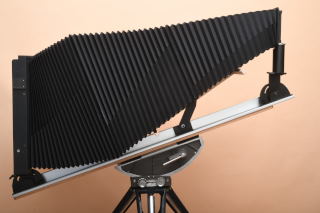

HOUSTON FEARLESS RTH HEAD. The RTH head will tilt 45 degrees fore or aft, but has a substantial counterbalance spring so it will not flop fore or aft. It is a pan/tilt head with 1 degree increments indicated.......whereas your typical head has 5 degree or 15 degree increments indicated. The pan/tilt locking handles are substantial and comfortable to work with. The RTH head was designed for use with an early portable microwave device. Look at the size of the counterbalance spring! The top plate came with only a 1/2"-13TPI threaded socket. No camera I know of requires such a large screw. Nevertheless I am supplying the head with a 1/2"-13TPI threaded stud. Actually, the microwave device probably has projections on the bottom to mate with the small sockets around the perimeter of the head; A bolt then engaged the threaded socket in the center of the head to secure the microwave device. If you want to put an ordinary camera on the head, I am also supplying the head with a 3/8"-16TPI threaded stud, which is the standard larger camera stud. 7X8" top plate. 7" diameter base. 3/8" wide key engages corresponding slot in tripod. Complete with Houston Fearless 2.725" diameter threaded retaining nut. The serial number of the head is #2500. No way H-F made 2500 such heads. It is more likely that H-F started with #2500. Wonderful chrome plated lever handles. Head revolves; note the 360 degree scale, with increments of 1 degree. Tripod without head weighs ~28#. $OLD








